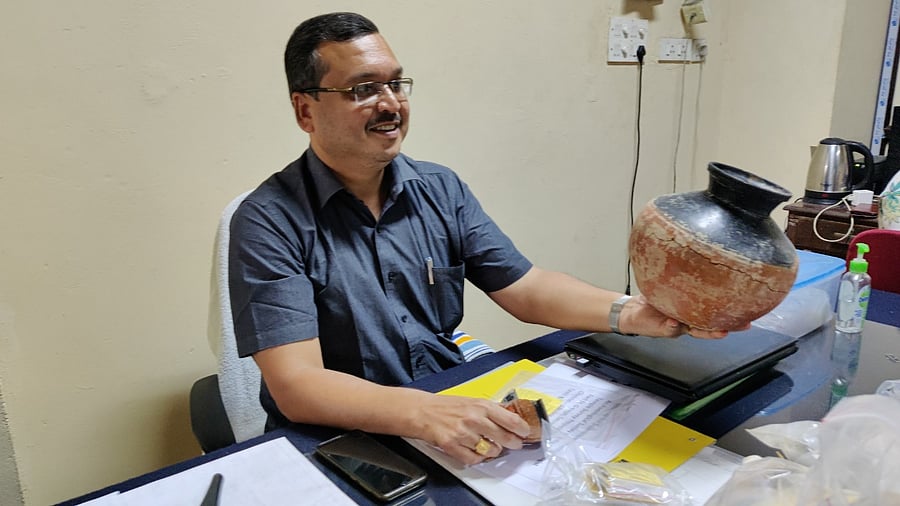
Amarnath Ramakrishna, Superintending Archaeologist of the ASI, with a pot unearthed from the Keeladi excavation site during the first two phases in 2015 and 2016.
Credit: ETB Sivapriyan/DH Photo
Chennai: Over two years after he submitted a 982-page report on the first two phases of the excavation at the Sangam Era site of Keeladi, the Archaeological Survey of India on Wednesday asked archaeologist K Amarnath Ramakrishna to “resubmit” the report after making necessary corrections suggested by two experts who vetted the document.
Ramakrishna, whose name is synonymous with Keeladi after he discovered the urban industrialized settlement 12 km south-east of Madurai in 2014, had submitted the voluminous report to the then ASI Director-General V Vidyavathi on January 30, 2023. The report, it is believed, was sent to a former ASI additional DG and a renowned academic for vetting.
Ramakrishna’s tenure as the in charge of Keeladi was mired in a row after he was abruptly transferred to Assam in 2017 and his successor claimed that there were no “significant findings” in the third phase. However, the Madurai Bench of the Madras High Court intervened and asked the Tamil Nadu State Department of Archaeology (TNSDA) to take over the excavations, which will enter the 11thphase this June.
About 20,000 artefacts have been recovered from Keeladi since 2014.
In the report, Ramakrishna relied on the Accelerator mass spectrometry (AMS) dating of 23 artefacts which established their age to be 300 CE to arrive at the expanded chronological sequence of Keeladi to be between 8th century BCE to 3rd century CE.
Ramakrishna, who is now Director (Antiquities), had said in his report that Keeladi’s fertile nature of land played a vital role in its evolution as an animal-based economy focussing on cattle and sheep goat herding, paving the way for excess production of rice and sea-fare trading of the inhabitants
Hemasagar A Naik, Director (EE), ASI, told Ramakrishna in a letter sent on Wednesday that the two experts have suggested corrections in the draft report to make it “more authentic.” The letter says the three periods require proper nomenclatures or re-orientation and the time bracket of 8th century BCE to 5th century BCE requires “concrete justification.”
“The other two periods should also be determined on scientific AMS dates and the material recovered with stratigraphical details. The date of the earliest period in the present state of our knowledge appears to be very early, it can be, at the maximum, somewhere in pre-300 BCE,” the letter, which was accessed by DH, said.
The letter also only mentioning depth for the available scientific dates is not enough, but the layer number should also be marked for comparative consistency analysis and asked Ramakrishna to resubmit the report after making the necessary corrections.
DH had reported on February 3, 2023, that the voluminous report, which contains detailed photographs and diagrams of the trenches, has 12 chapters that explains the historical background and objective of the excavation, besides dwelling into the structural remains, potteries, graffiti shreds, and terracotta objects that were found between 2014 and 2016.
A retired archaeologist, who wished to remain anonymous, said asking Ramakrishna to resubmit the report was only a “tactic” to further delay the report on an important excavation in Tamil Nadu.
“People are today more aware of archaeology because of the findings in Keeladi. Vetting the report of an archaeologist which consist of his opinion itself isn’t a welcome development. Anyone can agree or disagree with the excavator on his findings but vetting the report and asking him to rewrite is unacceptable,” the retired archaeologist told DH.